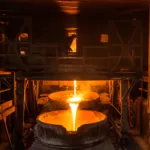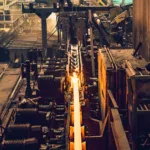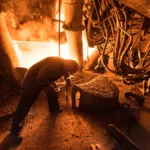A Step-by-Step Guide to Efficient and Safe Smelting
Melting—also known as smelting or refining—is the process of transforming metal ores or scrap into liquid form to achieve the desired alloy composition. Among modern melting methods, induction furnaces stand out as one of the most efficient, clean, and controllable systems, especially for the production of steel, cast iron, and ferrous alloys.
However, to ensure these systems operate safely, sustainably, and at maximum efficiency, melting must follow a well-planned, technically grounded procedure. In this guide, we break down each phase of the induction melting process, key safety points, and performance-enhancing best practices.
How Induction Melting Works
Induction furnaces melt metal through a high-frequency electromagnetic field generated by a coil surrounding a graphite or ceramic crucible. This induces eddy currents inside the metal, causing internal molecular friction and heat buildup. The result: fast, uniform internal heating from the inside out.
Advantages of Induction Melting:
-
High energy efficiency
-
Rapid temperature rise
-
Minimal oxidation and alloy loss
-
Clean, compact, and environmentally friendly operation
Step-by-Step Melting Procedure
1. Crucible and Refractory Inspection
-
Check for cracks, wear, and any signs of metal leakage
-
Ensure sintering has been completed if newly lined
-
Do not proceed with melting if leakage is suspected
2. Scrap & Charge Material Preparation
-
All scrap (HMS, DKP, castings, chips) must be clean, dry, and free of oil or paint
-
Moisture in the charge can cause explosions and refractory damage
-
Scrap composition must align with target steel chemistry
e.g., DKP + HMS blend for low-carbon steel
-
If using recycled returns, alloy balancing is essential
3. Charging the Furnace
-
Charge progressively based on furnace power and crucible capacity
-
Start with large, dense pieces; then add finer scrap as melting progresses
-
Avoid charging the full load at once—staggered feeding supports stability
-
Increase power gradually; metal typically liquefies within minutes
-
Monitor temperature frequently and maintain 1500–1600°C
-
Use mixing/stirring to ensure uniform temperature and alloy distribution
4. Slag (Sludge) Management
-
Surface slag must be removed regularly to:
-
Prevent alloy imbalance
-
Protect the refractory lining
-
Maintain casting quality
-
-
A clean crucible improves heat transfer and flow behavior
5. Chemical Sampling & Alloy Adjustment
-
Once metal is fully molten, collect samples for analysis
-
Add carbon, manganese, silicon, or chromium as needed
-
Alloy additions should be precisely calculated
Overdosing raises costs; underdosing reduces quality
6. Final Temperature & Casting Readiness
-
Maintain casting temperature between 1550–1600°C
-
This ensures optimal fluidity, homogeneity, and pourability
7. Pouring Process
-
Pour molten metal into the tundish or mold slowly and steadily
-
Prevent overflow and spillage—liquid metal should only contact lined surfaces
-
After casting, allow the furnace to cool gradually and reinspect the lining
Critical Melting Precautions
-
Do not charge wet, painted, or contaminated scrap
-
Always follow a gradual and controlled charging process
-
Remove slag regularly to prevent contamination
-
Avoid over-mixing, which may cause temperature fluctuations
-
Only make alloy adjustments after verified analysis
-
Overheating can crack refractories or shorten lining life
-
Power failure during melting may cause the metal to freeze and damage equipment
Advantages of Induction Melting
-
Fast heat-up and short melt times
-
Exceptional energy efficiency
-
Low oxidation and material loss
-
Precise temperature and chemistry control
-
High throughput with compact furnace systems
-
Low carbon emissions and cleaner operation
How Alpha Refractory LLC Supports Your Melting Operations
Successful melting depends on more than just furnace power—it requires engineering insight, process control, and refractory expertise.
At Alpha Refractory LLC, we provide:
-
Refractory lining installation and sintering support
-
Scrap and alloy mix optimization
-
Slag control and furnace energy efficiency planning
-
On-site engineering guidance and process consulting
-
Quality control planning and pre-casting analysis




